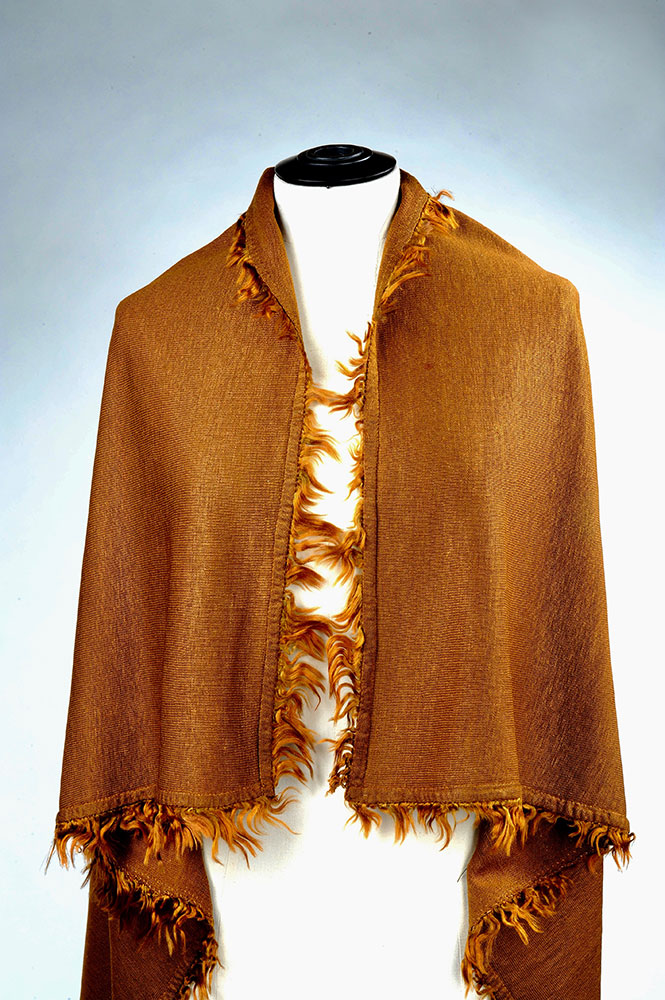Shawl with fringes
Shawl with fringes, 1st half 17th century? Naples? F-Lyon, Musée des Confluences, inv. 44002200 (MS Inventory 46).
Sea silk, plain right knit, 8 stitches/1 cm. Fringes ca 4 cm; mounted on a fabric tape, covered with knitted stripes 9 mm hand-sewn; 112 x 104 cm, weight 400 gr; on one side strong hardened stains.
This shawl, the heaviest object inventoried to date, is still full of mystery. It was bought privately by the former Museum d’Histoire naturelle de Lyon (now Musée des Confluences) in Lyon. A written reference dates it to the first half of the 17th century.
Is it the same shawl that was offered to Jules Richard in Monaco at the beginning of the 20th century? In the files of the Musée océanographique in Monaco, founded in 1910, of which Dr Jules Richard became the first director, there is a letter dated 15 June 1905 from Dr Richard to Prince Albert I: “Un italien propose l’achat, pour 700 lires, d’une sorte de fichu de 1 mètre carré fait en byssus de Pinna. Je crois pouvoir à priori décliner cette offre!” , (in English: An Italian offers, for 700 lire, a kind of 1 square meter kerchief made of Pinna byssus. I think I can decline this offer!)
In the 2008 brochure describing the way from the Museum d’Histoire naturelle to the Musée des Confluences, we find a reference to this shawl among the purchases made between 2000 and 2008: “Châle en soie marine, Italie, Probablement 1re moitié du XVIIe s. – Achat à E. Armato, Italie. C.3.4 Le matériel à portée historique Au sein des collections du musée des Confluences, la collection de papillons séricigènes de l’ancien laboratoire de la Condition des Soies de Lyon allie une grande valeur scientifique à une valeur historique indéniable. Cette collection renferme de très nombreux papillons, cocons, fils et tissus de soie dont un exceptionnel échantillon de soie d’araignée. Aussi, lorsque, après des années de veille documentaire, s’est présentée l’opportunité d’acquérir une pièce en soie marine, c’est-à-dire confectionnée avec la soie d’un coquillage méditerranéen dénommé Jambonneau de Mer, l’occasion a bien sûr été saisie, à l’issue d’une longue négociation.” , (in English : Sea silk shawl, Italy, probably 1st half of the 17th c. – Purchase from E. Armato, Italy. C.3.4 Material with historical significance. Within the collections of the Musée des Confluences, the collection of sericogenic butterflies from the former laboratory of the Condition des Soies de Lyon combines great scientific value with undeniable historical value. … So when, after years of documentary research, the opportunity arose to acquire a piece of sea silk, i.e. made from the silk of a Mediterranean shell called Jambonneau de Mer, the opportunity was of course seized, after lengthy negotiations.)
“Une pièce phare : Châle en soie marine, Collection du Département du Rhône – Muséum, Un objet historique ! Le Muséum conserve la collection de l’ancien Laboratoire de la Condition des Soies de Lyon. C’est la première collection au monde pour la soie sauvage, c’est-à-dire sécrétée par des papillons autres que le bombyx du mûrier. La possibilité d’acquérir une pièce historique remarquable confectionnée en soie marine fut une opportunité exceptionnelle de compléter cette collection. La soie marine est une fibre naturelle formée des filaments sécrétés par un bivalve marin, le Pinna nobilis, aujourd’hui interdit de récolte. Ce châle de grande dimension (110 cm x 100 cm) est un des deux seuls connus à ce jour.” (in English : A key piece: Sea silk shawl, Collection of the Rhône Department – Museum, A historical object! The Museum holds the collection of the former Laboratoire de la Condition des Soies de Lyon. … The opportunity to acquire a remarkable historical piece made of sea silk was an exceptional opportunity to complete this collection. Sea silk is a natural fibre formed from the filaments secreted by a marine bivalve, the Pinna nobilis, which is now prohibited from being harvested. This large shawl (110 cm x 100 cm) is one of only two known to date.

